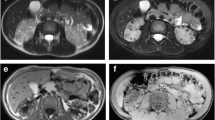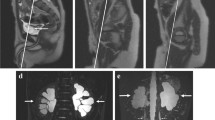Abstract
Background
We have intermittently observed low signal striations in the kidneys on delayed post-contrast MR exams of the spine. While we suspected these striations were due to concentrated gadolinium, the clinical importance of this finding was uncertain.
Objective
To describe the striated MR nephrogram (low signal striations in the kidney) and assess its clinical relevance.
Materials and methods
Retrospective review of delayed post-contrast MRIs of the spine (mean: 45 min after contrast administration). The presence of the striated MR nephrogram was correlated with imaging parameters (field strength, time since contrast), and findings (gadolinium in the bladder, inferior vena cava and aorta diameters) and with clinical factors (history of renal disease, laboratory values).
Results
Seven hundred seventy-three exams performed on 229 patients, 8.3 ± 5.3 years of age, were reviewed. The striated MR nephrogram was observed in 102/773 examinations (13.2%) and was present on at least one study in 54/229 patients (23.6%). The presence of striations was associated with the specific magnet on which the exam was performed (P < 0.01) but not with magnet field strength. Serum creatinine was minimally lower in patients with striations (0.43 ± 0.12 vs. 0.49 ± 0.18 mg/dL, P = 0.002), but no other clinical or historical data, including time from contrast administration (P = 0.54), fluid status (P = 0.17) and clinical history of renal disease (P = 0.14), were predictive of the presence of striations.
Conclusion
The striated MR nephrogram was observed in 13% of delayed post-contrast MR exams of the spine. Precipitating factors are unclear, but the striated nephrogram does not appear to be a marker of clinically apparent renal dysfunction.





Similar content being viewed by others
References
Elster AD, Sobol WT, Hinson WH (1990) Pseudolayering of Gd-DTPA in the urinary bladder. Radiology 174:379–381
Kosiak W, Swieton D, Piskunowicz M (2008) Sonographic inferior vena cava/aorta diameter index, a new approach to the body fluid status assessment in children and young adults in emergency ultrasound–preliminary study. Am J Emerg Med 26:320–325
Du L, Zukotynski K, Hsiao E et al (2009) Pediatric reference ranges for glomerular filtration rate determined by a single injection of Tc-99 m DTPA. J Nucl Med 50:1375
Gordon S, Sethna C, Frank R et al (2010) BUN:creatinine ratio - definition of the normal range in children. Nephrol Rev 2:e11
Kokko JP (1987) The role of the collecting duct in urinary concentration. Kidney Int 31:606–610
May DA, Pennington DJ (2000) Effect of gadolinium concentration on renal signal intensity: an in vitro study with a saline bag model. Radiology 216:232–236
Conflicts of interest
None
Author information
Authors and Affiliations
Corresponding author
Rights and permissions
About this article
Cite this article
Trout, A.T., Zhang, B., Care, M.M. et al. The striated MR nephrogram, not a reflection of pathology. Pediatr Radiol 45, 1644–1650 (2015). https://doi.org/10.1007/s00247-015-3388-7
Received:
Revised:
Accepted:
Published:
Issue Date:
DOI: https://doi.org/10.1007/s00247-015-3388-7




